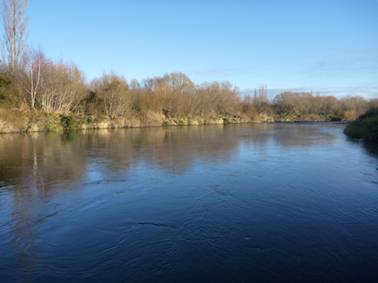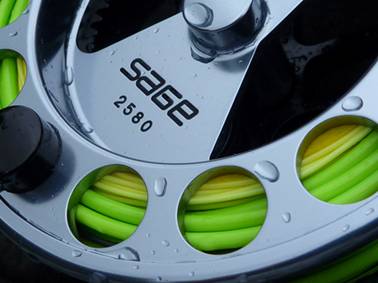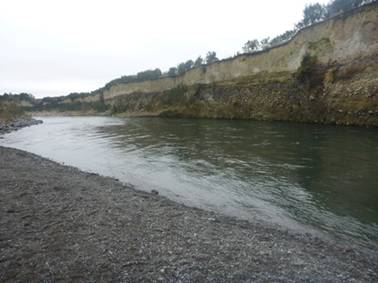SWITCH IN NZ

I have had a Switch rod for a while now but have only recently given it a real go, starting with a trip to the Ohau Channel in Rotorua. I managed to catch a good fish just after dark but I paid the price for not casting as well as I could by having a sore shoulder for the next week and quite a few tangles to try to sort out. To say I struggled a bit is an understatement.
I have since done a fair bit of research on the web and watched quite a few Spey casting videos including Rio's Modern Spey Casting which has helped me a lot.
I have now, I think, got a bit of a handle on the Switch fishing on the Tongariro and thought I would try to pass on some thoughts. I have fished the Tongariro for a total of 8 days with the Switch rod and have managed to fish for 4 days straight without getting the single hander out and without getting too tired and even managed to catch more fish than my mates with single handers. So as you can see I am still a beginner!
One of the things I quickly realized is that even a very fast sinking poly leader does not sink fast enough for streamer fishing on most pools on this river. They would be fine on most rivers but the trout of the Tongariro tend to hold deep and right in the current line so you need to get deep and quickly. There is a saying on the Tongariro that if you are not on the bottom you are not fishing. Most of the fish are not river resident, but have run up to spawn and are not feeding so they hug the bottom to conserve energy.
The best way I have found to fish a wet-line with a switch rod is to use a Skagit line with a length of T12 or T14 on the end. I have used 16 feet of both with success, but with that much weight on the end, it is not a pretty cast ("T" material is a straight piece of heavy sinking line) I would recommend maybe 10 or 11 feet of T12 then a short tippet to a large fly like a bead head wooly bugger or a cone head Rabbit in just about any colour. With this set up I can hit the far bank with a good cast and get a good swing all the way across. The picture of my reel shows the Skagit head very well and the dark line you can just see in the lowest port is the T12.

If you want to fish Tongariro style nymph rigs you can use the Skagit line and replace the T12 with about 14 to 16 feet of nylon to a heavy "bomb" nymph with a short trace tied from the bend of the bomb to a smaller nymph or glo bug. This will work just fine but if you are not very careful it can lead to some fantastic tangles. One option to help is to use a floating poly leader of 10 feet with an indicator on the end and then 12 to 14 feet of nylon to your nymphs, this will cast and turn over better but not sink quite as fast.
Another option and the one I prefer is to have a Skagit head on one spool and a Scandi head on another spool. The Scandi head is much better at casting long leaders and nymphs and once you get the hang of touch and go casting is a fantastic nymphing tool. I use an Indicator on the end of the head then 2 rod lengths (yes 22 feet) of leader with 2 nymphs on the end. The extra length of leader helps the nymphs to sink fast and get deep and also helps to anchor the cast. If you have room for a backcast you can use the Scandi head 2 hand overhead style and if you have no room a single Spey or a snake roll works very well. Once you have nymphed through the pool change spools to your Skagit head, turn around and fish through the other way, it is amazing how many fish you can get on the second pass.

The indicator on the end really helps when you are drifting your nymphs through a run that is 80+ feet away. When striking at this range lifting the rod is too slow so I tend to sweep the rod horizontally toward the bank as this tends to work much better. I have hooked the pumice cliff on the far bank of the Cicada pool with almost no effort and taken fish from hard against the cliff, that would be a mighty cast with a single hander.
One of the questions I get asked is "why use a switch if you can fish with a single hander?" Well, two of my mates and I recently fished the lower bridge pool, we fished upstream nymphing behind a couple of other guys and all the single handers were casting roughly the same distance up and across, maybe 60 feet across max as they need to get a long way upstream to get a good long drift so the flies get down deep. I followed up behind them with my Switch rod and Scandi line and could easily reach much farther across the pool and picked up fish that the other guys just could not cast to. Of course as the fish get disturbed by the constant casting over them they move further and further out and a good cast, even 10 feet further than the other guys can manage, can put your nymph where the fish are. One of the things I look for now is a pool that has had a bit of a thrashing by the indicator nymph fishing guys as they will have pushed the fish into a fairly narrow band just out of their casting range, but well within mine.
I am enjoying the learning curve with my Switch rod and I think the challenge is half the fun, but if you fancy giving it a go, get yourself some instructional DVDs like Rio's they really make a big difference.
A switch rod is not the tool for every fishing situation but on the big water and off the beaches it is fantastic. If you get a chance to fish with a shooting head off the beach casting 2 handed overhead you will be amazed at the distance you can cast after only a short practice.
At the moment here in NZ you will not see too many guys using 2 handed rods but they are slowly catching on and I think once the salt water guys realize the advantages and potential of them they will take off. The South Islands big braided rivers are perfect for the Switch rod, as is any of the rivers that have a wide estuary and sea run browns or Salmon.
For now I am enjoying watching the faces of the single hand guys when I manage a cast almost to the far bank and still manage to control the drift and strike the fish at that distance, All the best.
Mike
